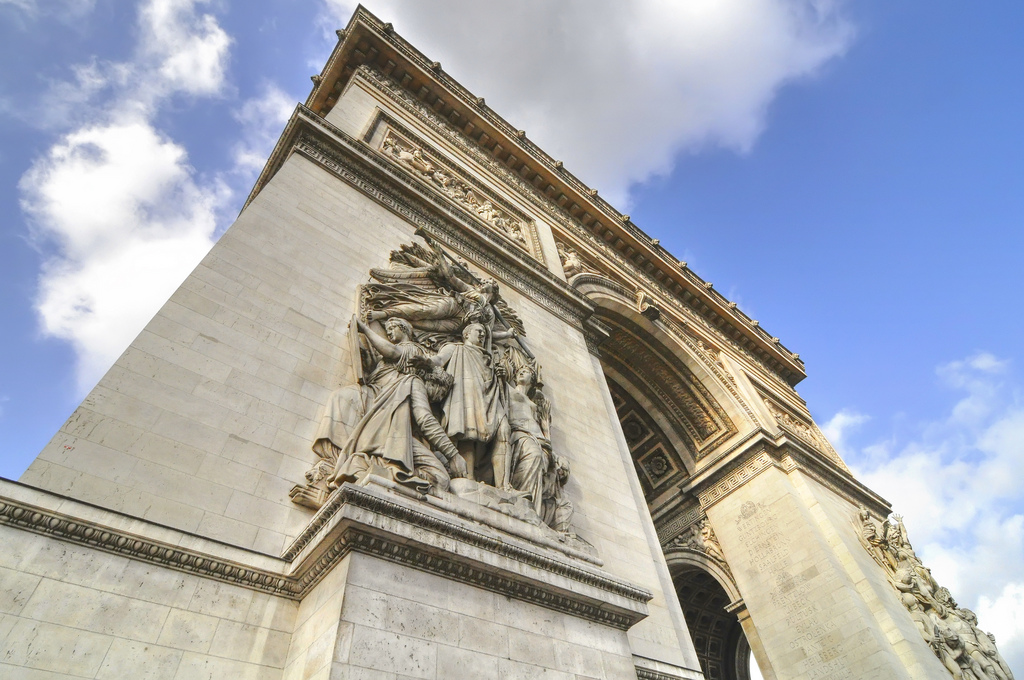
In part 1 of this guide, we covered the basics about Paris. Now it is time to detail each Arrondissement. In this section, we will cover the main landmarks and museums, restaurants and hotels of each district.
Paris: general tips
These apply to all arrondissements:
- Museums are free on the first Sunday of the month, from October to March.
- Restaurant menus are better value for money than a la carte options.
- Most top restaurants (including the Michelin stars) serve very affordable menus at lunchtime.
1er Arrondissement
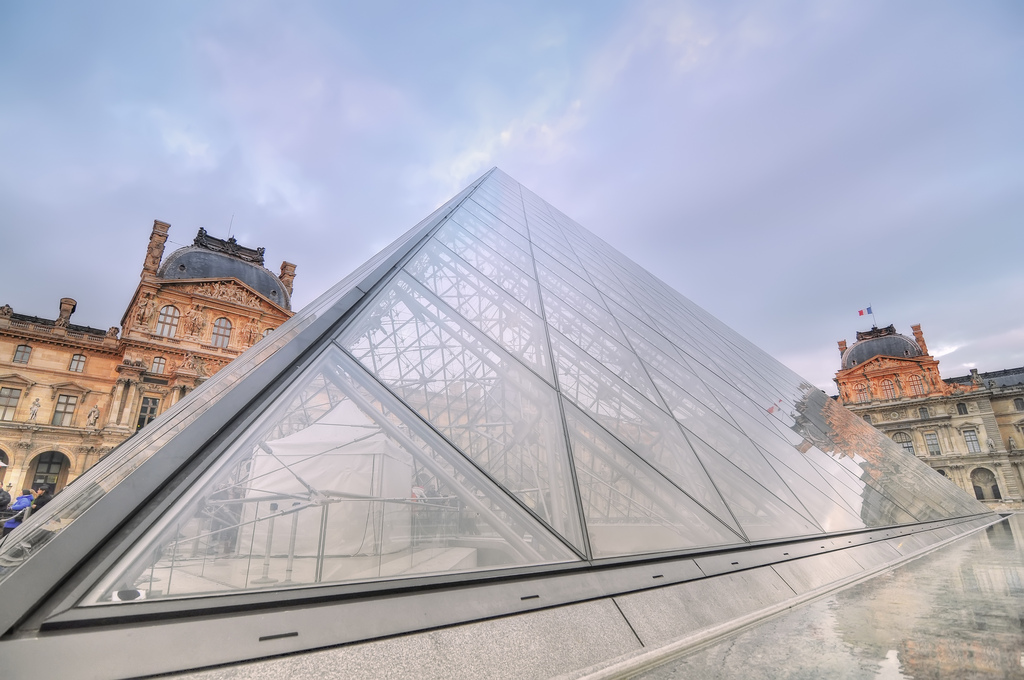
Musée du Louvre, 1er Arrondissement
This is the geographical center of Paris. The kilometre zero is at the Place du Parvis de Notre Dame, but Baron Haussmann moved the city center to the Royal Quarter when he was in charge of carving up the city. Many landmarks of Paris are located here:
- Arc de Triomphe du Carrousel: built to celebrate Napoleon’s military victories, located between the Louvre and the Jardin des Tuileries. M1 or M7, Palais Royal-Musée du Louvre station.
- Bourse de Commerce: house of Paris’ chamber of commerce, this was built as a large grain market in 1767 and features one of the most impressive domes in Paris. M4, Les Halles station.
- Église Saint-Eustache: a large gothic church next to the Forum de les Halles. M4, Les Halles station.
- Forum de Les Halles: a complex featuring a beautiful garden at street level and a big shopping center underground. Next to it is the most confusing Metro/RER station in Paris: Châtelet-Les Halles. RER A, B or D, Châtelet-Les Halles station, or M4, Les Halles station.
- Jardin des Tuileries: a large garden just west of the Louvre. It houses the Musée de l’Orangerie, famous for Monet’s Water Lilies, and the seasonal ferris wheel. M1, Tuileries station.
- La Conciergerie: a medieval fortress where queen Marie Antoinette was imprisoned and executed. The clock tower was recently cleaned and should be visited. M4, Cité station.
- Musée du Louvre: one of the world’s greatest museums, famous for its glass pyramid designed by architect I.M. Pei and a fabulous collection of over 380000 objects and 35000 works of art. The museum is massive, so if you want to see everything, plan at least two full days. The best alternative, though, is to go to the Louvre’s website, pick what you want to see and mark it on the map. Pay special attention to the Mona Lisa: its room is always packed with tourists, to try to go at night (Wednesday and Friday, until 9:45PM) or during lunchtime, which are the less crowded times. Although you may want to enter the museum through the pyramid, the lines are much shorter if you enter through the Carrousel du Louvre mall. Buy the ticket on the machines before the escalators down the mall and enter via the secondary entrance in front of the inverted pyramid (across the Apple Store). M1 or M4, Palais Royal-Musée du Louvre station.
- Palais Royal: housed Louis XIV until his move to Versailles. It features a beautiful garden enclosed within the buildings. M1 or M4, Palais Royal-Musée du Louvre station.
- Place Vendôme: probably the center of luxury in Paris. Home of the Ritz hotel and several jewelers and fashion labels — Cartier, van Cleef and Arpels, and others. It is famous for the Colonne Vendôme, which is a replica of the original column, brought down during the 1871 Paris Commune. M1, Tuileries station.
- Pont des Arts: famous for the lovelocks attached to the bridge. M7, Pont Neuf station.
- Pont Neuf: despite of its name, it is the oldest standing bridge in Paris. M7, Pont Neuf station.
- Sainte Chapelle: in my opinion, the most beautiful church in Paris, originally built to house the relics of the Crown of Thorns. Visit it during a sunny day to see it in all of its glory — the sunlight coming through the stained glass windows is one of the most unique sights in the city. M4, Cité station.
Recommended restaurants, cafés and bars. Like most things in this area, food is very expensive:
- Bar Hemingway: one of the most traditional bars in Paris (and the best one, in my opinion), at the Ritz hotel. Very expensive. 15 Place Vendôme. M1, Tuileries station.
- Le Meurice: Alain Ducasse’s famous restaurant at the Le Meurice hotel. The majestic restaurant room is inspired by the Salon de la Paix in the Château de Versailles, with windows overlooking the Jardin des Tuileries. Recommended for the admirers of the Haute Cuisine. Very expensive, requires reservations. 228 Rue de Rivoli. M1, Tuileries station.
- Macéo: nice restaurant with a good wine selection. Midrange to upscale prices.15 Rue des Petits Champs. M1 or M7, Palais Royal-Musée du Louvre station, or M3, Bourse station.
- Spring: very good and creative French menu. There is no carte; they just serve a fixed-price dinner. 6 Rue Bailleul. M1, Louvre-Rivoli station.
- Yam’Tcha: an interesting Asian-fusion restaurant, mixing French heritage with ingredients from China. M1, Louvre-Rivoli station.
Recommended hotels. Like food, good hotels in this area are very expensive (4-5 stars).
- Best Western Premier Hotel Opéra Richepanse, M8, M12 or M14, Madeleine station.
- Citadines Suites Louvre, M1 or M7, Palais Royal-Musée du Louvre station.
- Hôtel Ritz, M1, Tuileries station.
- Le Burgundy Paris, M8, M12 or M14, Madeleine station.
- Le Meurice, M1, Tuileries station.
- Novotel Paris Les Halles, Châtelet-Les Halles. RER A, B or D, Châtelet-Les Halles station, or M4, Les Halles station.
2e Arrondissement
This district screams finances. It is the home of the stock exchange (Bourse) and the CAC 40 index. There isn’t much to do here as a tourist. The main sights are:
- Bibliothèque Nationale de France, Richelieu: as the name says, a library. The Cabinet des Médailles is worth a visit. M3, Bourse station.
- Bourse: the stock exchange. M3, Bourse station.
- Place des Victoires: a beautiful square featuring a Louis XIV statue. Also visit the Notre Dame des Victoires, a 17th century church nearby. M3, Bourse station.
- Tour Jean-sans-Peur: one of the last remnants of medieval Paris, it is a tower that once belonged to the Hôtel de Bourgogne castle. M4, Étienne-Marcel station.
Recommended hotels:
- Park Hyatt Paris-Vendome, M3, M7 or M8, Ópera station.
3e Arrondissement
A mostly residential area in the Marais neighborhood. Not very touristy, but there are some interesting things to see here:
- Archives Nationales: museum of French history. M11, Rambuteau station.
- Musée national des Arts et Métiers: a nice museum for engineers and people who like engineering. Features prototypes of most important inventions, a Foucault pendulum and many artifacts from the creation of the Statue of Liberty. M3 or M11, Arts et Métiers station.
- Musée Picasso: exhibits many works of Picasso and others. M8, Chemin Vert station.
Recommended restaurants:
- Camille: excellent French food. 24 Rue des Francs-Bourgeois. M1, Saint Paul station.
- Chez Janou: good food and beautiful location. 2 Rue Roger Verlomme. M8, Chemin Vert station.
- Le Petit Marché: a nice small bistro. 9 Rue de Béarn. M8, Chemin Vert station.
4e Arrondissement
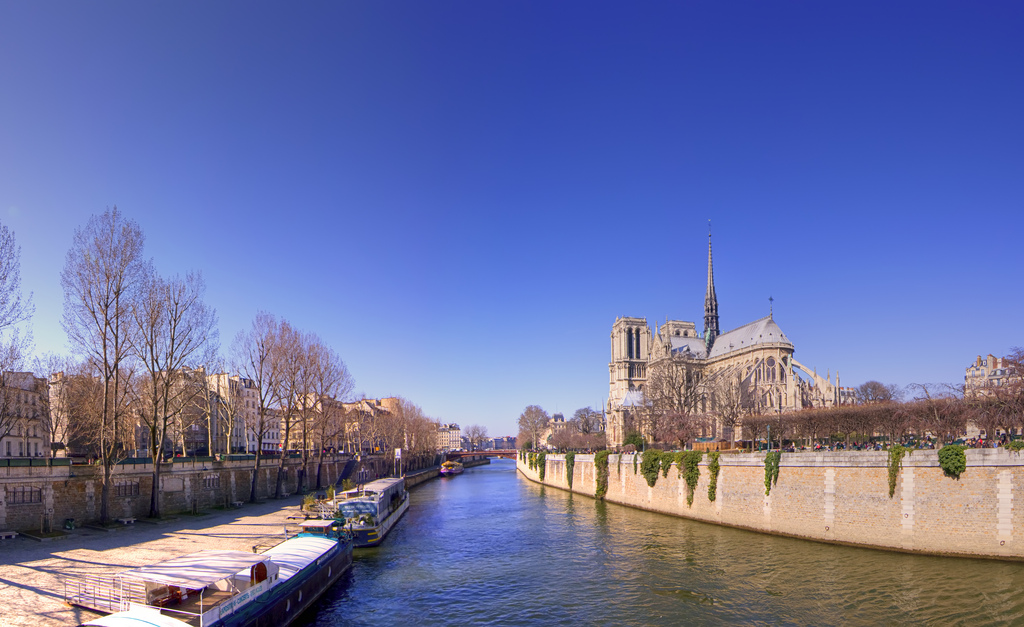
Notre Dame de Paris and the Seine river, 4e Arrondissement
This district used to be a great part of medieval Paris. The kilometre zero, which marks the old center of Paris is located at the Place du Parvis de Notre Dame. A great number of landmarks are located here:
- Cathédrale Notre Dame de Paris: the most famous church in the city and one of the finest examples of gothic architecture in Paris. It houses 3 christian relics: the Crown of Thorns, a fragment of the True Cross and one of the Holy Nails. The lines to go up the tower are huge, but the view is great. Don’t miss the reliquary: it’s through a small path on the right side of the nave. RER B, Saint Michel-Notre Dame station, or M4, Cité station.
- Centre Georges Pompidou: one of the best contemporary art museums in the world and one of my favorite places to relax. The restaurant on the 6th floor is excellent too. M1 or M11, Hôtel de Ville station, or M11, Rambuteau station.
- Hôtel de Ville: Paris city hall and one of the most beautiful buildings in the city. In the winter, there is a skating rink in front of it. M1 or M11, Hôtel de Ville station.
- Mémorial de la Shoah: the Holocaust memorial. M7, Pont Marie station.
- Place de la Bastille: the actual fortress was destroyed during the French Revolution, and all that remains of it (just a small part of the foundation) can be seen at the M5 Bastille station, at the Bobigny/Pablo Picasso-bound platform. M1, M5 or M8, Bastille station.
- Place des Vosges: the oldest planned square in Paris, famous for the red brick houses surrounding it. While you are here, take a look at Victor Hugo’s house. M1, Saint Paul station.
- Tour Saint Jacques: the last standing piece of the Eglise Saint-Jacques-de-la-Boucherie. This was the meeting place in Paris for pilgrims going to Santiago de Compostella. Due to that, it is included in the UNESCO World Heritage List as one of the sites of the Routes of Santiago de Compostella. M1, Châtelet or Hôtel de Ville stations.
Recommended restaurants and cafés:
- Amorino: great gelato place. 47 Rue Saint Louis en L’Ile. M7, Pont Marie station.
- Georges: a nice fusion cuisine restaurant on the 6th floor of the Centre Georges Pompidou. It offers a great view of Paris. 19 Rue Beaubourg. M11, Rambuteau station.
- Le Loir dans la Théière: very good teashop. 3 Rue des Rosiers. M1, Saint Paul station.
5e Arrondissement
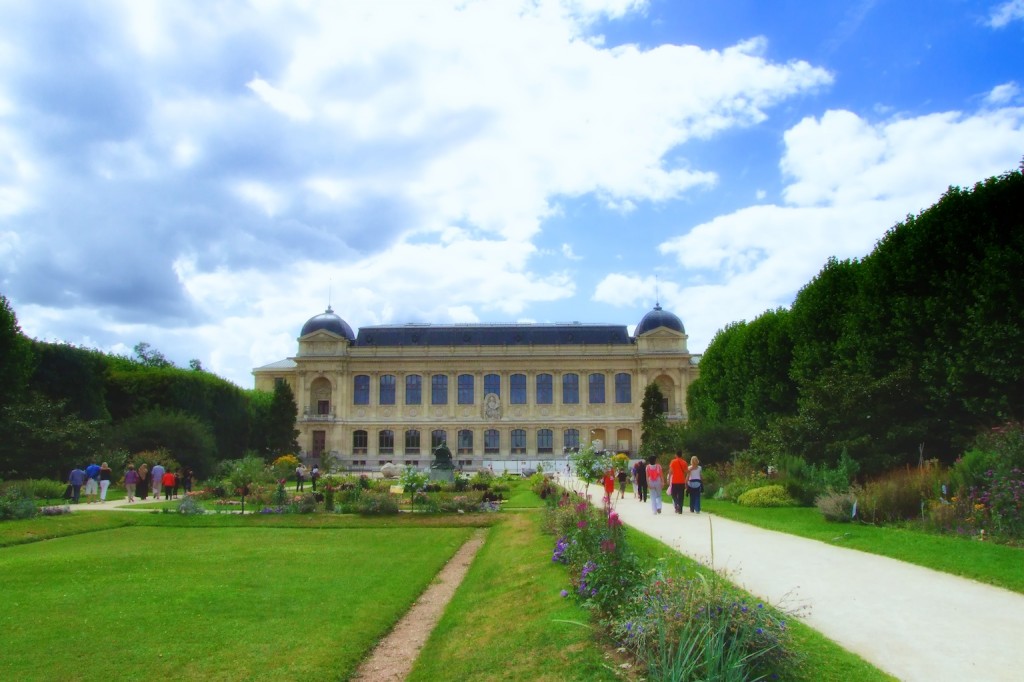
Jardin des Plantes, 5e Arrondissement
This district is also commonly referred as the “Quartier Latin” and is one of the most popular arrondissements of Paris. The main landmarks are:
- Arènes de Lutèce: ruins of a Roman amphitheater and the last remnant of old Lutetia. M7, Place Monge or Jussieu stations, or M10, Cardinal Lemoine or Jussieu stations.
- Eglise Saint-Étienne-du-Mont: a gothic-renaissance church, featuring the only rood screen in the city. M10, Cardinal Lemoine station, or RER B, Luxembourg station.
- Institut du Monde Arabe: a beautiful building designed by architect Jean Nouvel. Unfortunately, the most interesting thing in the building, the opening mechanism of the windows, is broken in almost all windows. Still, the terrace offers a different bird’s eye view of northern Paris for free. M7 or M10, Jussieu station.
- Jardin des Plantes: the Botanical Garden. Home of over 10000 species, plus a small zoo (La Ménagerie) and the Musée d’Histoire Naturelle (Natural History Museum). The museum is not as good as others, like London’s NHM and New York’s AMNH. So you may skip that if you’ve already been to one of those and have little time to visit the city. M7 or M10, Jussieu station (closer to the museum), M5, M10 or RER C, Gare d’Austerlitz station.
- Musée Curie: the preserved laboratory and offices of Pierre and Marie Curie, Nobel Prize winners of 1903 for their work on radioactivity. RER B, Luxembourg station.
- Musée du Moyen Age: a 15th century abbey with a large collection of medieval artifacts, plus the ruins of Roman baths. M10, Cluny-La Sorbonne station.
- Panthéon: originally a church in honor of St. Geneviève, the saint patron of Paris, it is a mausoleum where many notable Frenchmen are buried: Voltaire, Rousseau, Victor Hugo and Alexandre Dumas, among others. It is one of my favorite buildings in Paris — very quiet and very beautiful, and there is a Foucault pendulum hanging off the dome. The view from the dome is very cool. M10, Cardinal Lemoine station, or RER B, Luxembourg station.
- Paris-Sorbonne: one of the most famous universities in the world. M10, Cluny-La Sorbonne station.
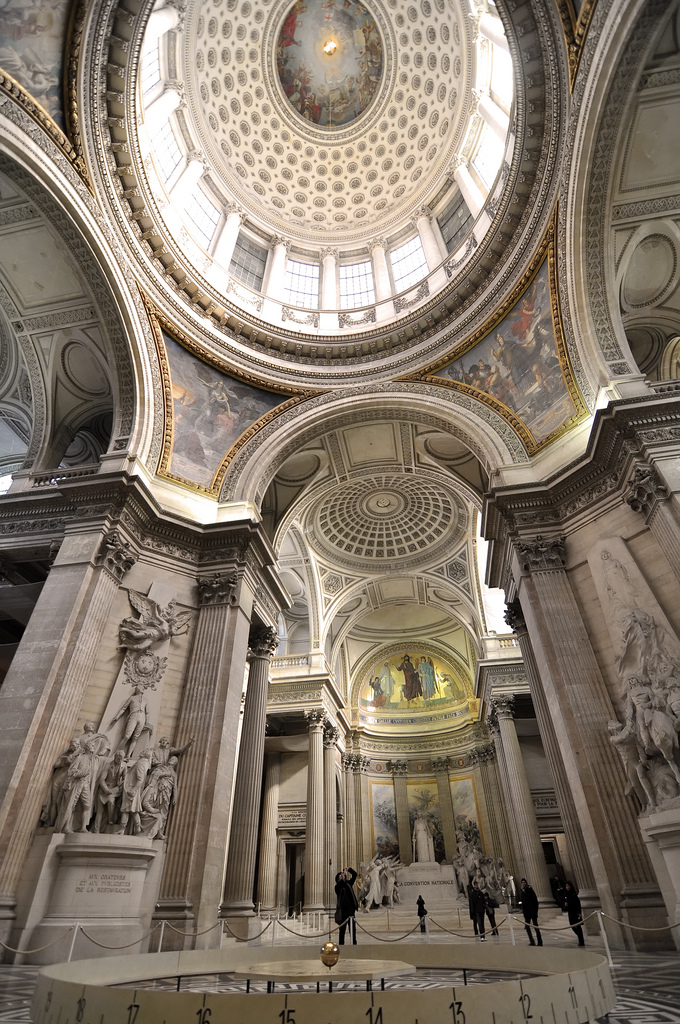
Interior of the Panthéon, 5e Arrondissement
Most restaurants here are overpriced tourist traps. I can recommend one place:
- La Tour d’Argent: one of the oldest restaurants in Paris, offering a stunning view of Notre Dame, famous for its duck recipes. Very expensive. 15 Quai de la Tournelle. M10, Maubert-Mutualité station.
Recommended hotel:
- Hotel Mercure Paris La Sorbonne, M10, Cluny-Sorbonne station.
6e Arrondissement
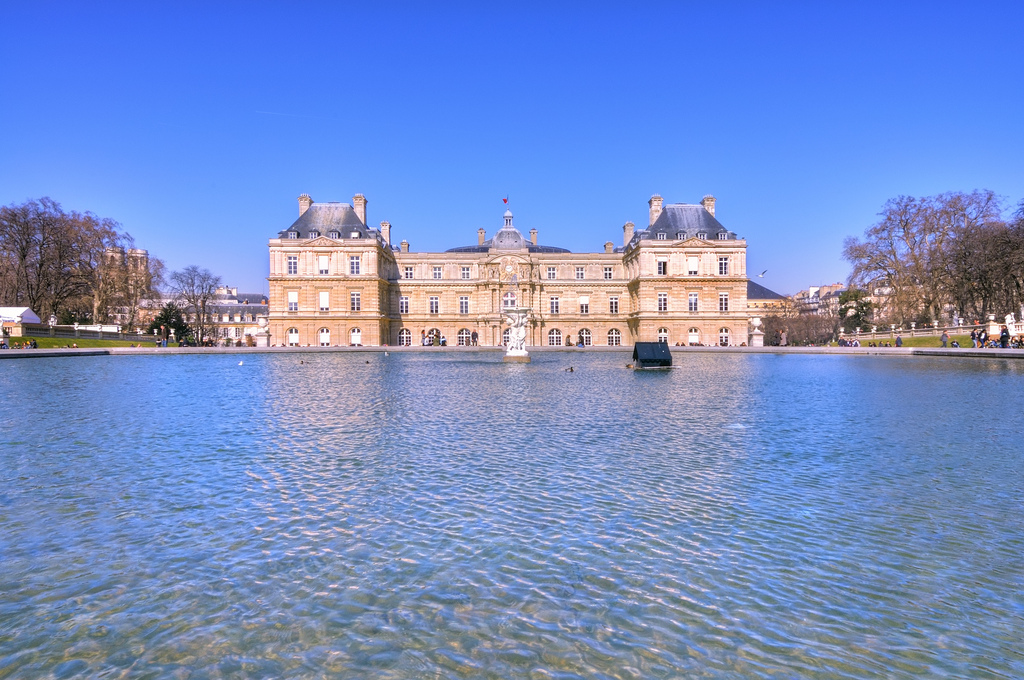
Palais du Luxembourg, 6e Arrondissement
Best known for two things: Jardin du Luxembourg and restaurants. Main landmarks:
- Église Saint-Germain-des-Prés: it is the oldest church of Paris. M4, Saint-Germain-des-Prés station.
- Église Saint-Suplice: the second largest church in Paris, after Notre Dame. The church was made famous by Dan Brown’s Da Vinci Code. The Dome of the Lady Chapel and the Great Organ are worth a visit. M4, Saint-Suplice station.
- Jardin et Palais du Luxembourg: the Jardin du Luxembourg is one of the largest parks in Paris. Its adjacent palace, the Palais du Luxembourg is the seat of the French Senate. It is a very nice area to relax in the city. One of Bartholdi’s Statues of Liberty (actually the first model built) is located here, on the western end of the park, near the carrousel. RER B, Luxembourg station.
- Musée National Eugène Delacroix: the building used to be Delacroix’s home late in his life. The museum features several of his works. M4, Saint-Germain-des-Prés station.
Recommended restaurants:
- Huîtrerie Régis: the best oysters and seafood in town and a great selection of Loire Valley wines. 3 Rue de Montfaucon. M4, Saint-Germain-des-Prés station, or M11, Mabillon station.
- Les Bouquinistes: owned by Guy Savoy, it serves good fresh food and offers a very Parisian atmosphere. 53 Quai des Grands-Augustins. RER B, Saint Michel-Notre Dame station.
- Ze Kitchen Galerie: a nice fusion restaurant owned by Guy Savoy. Impossible to get a table without a reservation. 4 Rue des Grands-Augustins. RER B, Saint Michel-Notre Dame station.
7e Arrondissement
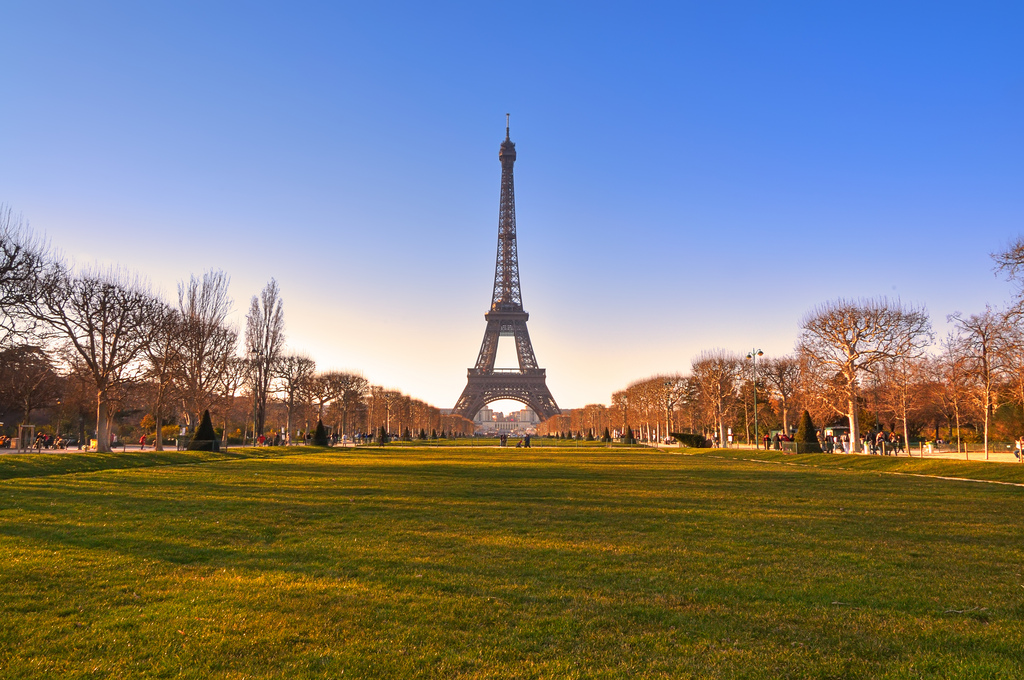
Tour Eiffel and the Champ de Mars, 7e Arrondissement
The most expensive area to live in Paris and home of the Tour Eiffel. There is a lot to see in this area:
- École Militaire: the Paris Military School complex. While you are around here, take a look at the curved UNESCO building right in front of it. M8, École Militaire station.
- Hôtel National des Invalides: initially commissioned as a hospital for war-wounded soldiers, now is the home of the Musée de l’Armée, one of the largest military museums in the world. Its collection spans from 13th century items to World War 2 artifacts. This complex also houses the Église du Dome, Napoleon’s burial place. M8, M3, or RER C, Invalides station, or M13, Varenne station.
- Musée des Egouts de Paris: if you are into doing something different, you may try a visit to Paris’ sewers. RER C, Pont de l’Alma station.
- Musée d’Orsay: a former train station converted into a museum. In my opinion, it is the best collection of Impressionism in the world. Works of Renoir, Monet, Manet and Van Gogh can be found here. RER C, Musée d’Orsay station.
- Musée du quai Branly: a tribal art museum near the Eiffel Tower, in the banks of the Seine. Honestly, the building and gardens are more interesting than the museum. RER C, Pont de l’Alma station.
- Musée Rodin: museum dedicated to the work of Auguste Rodin. The sculpture garden is worth a visit. M13, Varenne station.
- Palais Bourbon: houses the French National Assembly. Guided tours are available all day, but a government-issued photo ID is required. The most interesting thing in the building is Delacroix’s l’Histoire de la civilization painting. M12, Assemblée Nationale station, or M8, M3, or RER C, Invalides station.
- Tour Eiffel: the symbol of Paris and probably the most known landmark in the world. Built by Gustav Eiffel in the late 1800s for the 1889 World Fair, it was initially a temporary structure, but due to the importance of its telegraph antenna, it was kept in place. Today, it is one of the most visited places in the world and the tallest structure in Paris at 324m (1063ft). It is also home for Alain Ducasse’s Le Jules Verne restaurant. The lines are always a problem when visiting the tower, but it’s worth the wait. I advise visiting the tower in the late afternoon, so you can see Paris at daylight and at night in one visit. Plus, the projected shadow of the tower on the city is an amazing sight. The light shows start at sunset and happen every hour until 2AM. M6 or M9, Trocadéro station, for the Palais de Chaillot’s fountains view; or M6, Bir Hakeim station / RER C Champ de Mars-Tour Eiffel, for the closest walk; or M8, École Militaire station, for the Champ de Mars view.
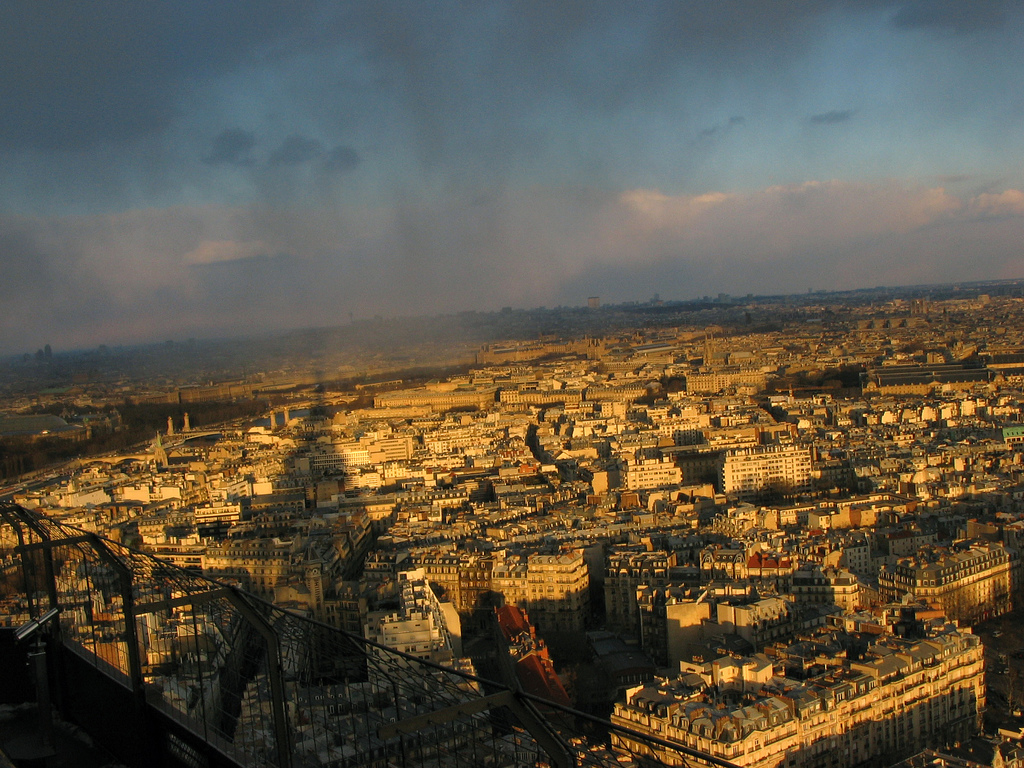
Shadow over Paris, from the Tour Eiffel observation deck
Recommended restaurants:
- La Brasserie Thoumieux: Jean-François Piège’s restaurant, serves great seafood dishes. Very expensive. 79 Rue Saint-Dominique. M8, La Tour-Maubourg station.
- Le Jules Verne: Alain Ducasse’s restaurant at the Tour Eiffel. Offers great food and a nice view. La Tour Eiffel. M6, Bir-Hakeim station.
- Le Voltaire: very traditional and chic French restaurant near the Musée d’Orsay. You will probably find some celebrities while dining here. Very expensive. 27 Quai Voltaire. M12, Rue du Bac station.
8e Arrondissement
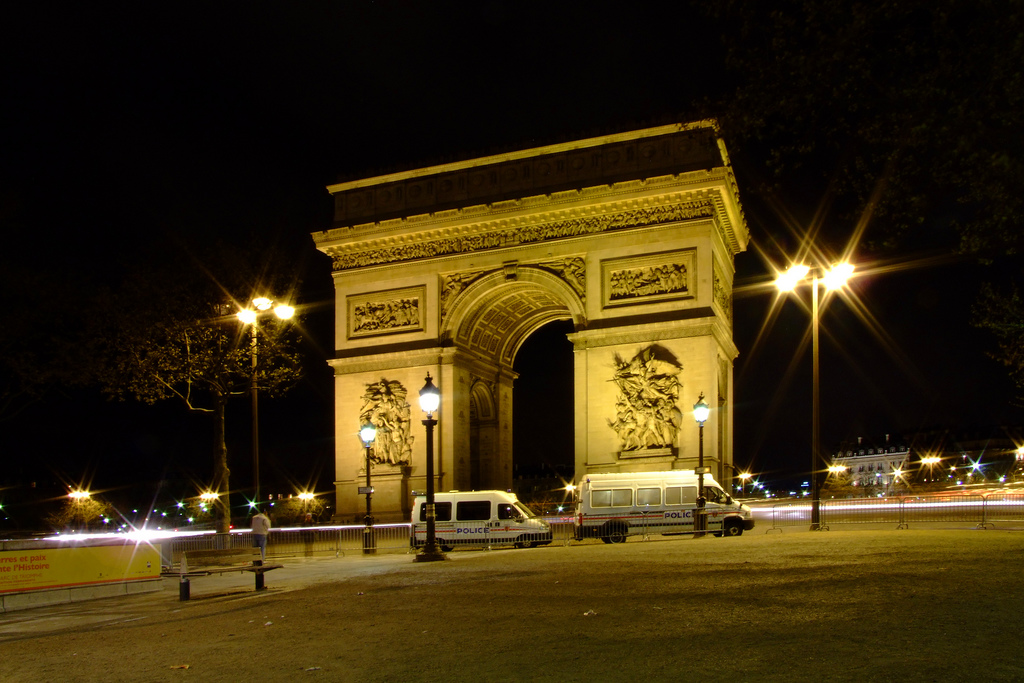
Arc de Triomphe de l’Étoile, 8e Arrondissement
Avenue des Champs-Elysées and the seat of French government. Also, the most expensive tourist traps for unadvised tourists. Avoid restaurants, bars and even fast food chains in this area. Main landmarks:
- Arc de Triomphe de l’Étoile: the most famous arc in Paris is located at the Place Charles de Gaulle (formerly known as Place de l’Étoile), the intersection of 12 avenues, including the famous Champs-Elysées. The historic axis of Paris runs through it, from the courtyard of the Louvre to the Grande Arche de La Defénse in Puteaux. Beneath the arc you will find the Tombe du Soldat Inconnu and its eternal flame, in honor of those who died in WW1. The view from the top of the arc is quite interesting and is worth a try. In order to get to the arc, you will need to go through an underground passage (there is one entrance right next to the Charles de Gaulle-Étoile station exit on the Champs-Elysées sidewalk). Do not try to cross the street at the roundabout, as it is an almost certain way to earn a Darwin Award. M1, M2, M6 or RER A, Charles de Gaulle-Étoile station.
- Avenue des Champs-Elysées: the most famous avenue in Paris, running from the Place the La Concorde to the Arc de Triomphe de l’Étoile, home of many luxury brands and one of the finest shopping addresses in the world. Needless to say, everything here is very expensive. M1, M2, M6 or RER A, Charles de Gaulle-Étoile station, if you want to walk to the Place of La Concorde; or M1, M8 or M12, Concorde station in case you want to walk to the Arc de Triomphe de l’Étoile.
- Église de la Madeleine: the Neo-Classical temple sustained by 52 Corinthian columns is one of the most known churches in Paris. The interior is very beautiful, as a lot of marble and gold were used. Chopin’s funeral took place in here in 1849. M8, M12 or M14, Madeleine station.
- Grand Palais: a very large museum. An installation called Leviathan, by Anish Kapoor, fills about half of the building. The building itself is much more interesting than anything exhibited in there. M1 or M13, Champs-Elysées-Cleménceau station.
- Petit Palais: an art museum with a diverse collection. The 19th century paintings and sculptures collection is very interesting. While you are here, take a look at the statue of Winston Churchill outside the palace. M1 or M13, Champs-Elysées-Cleménceau station.
- Place de La Concorde: it is the largest public square in Paris, famous for the 3300-year old Obelisk of Luxor at its center and its two fountains. There are eight corners and each one has a statue representing a French city — Brest, Rouen, Lyon, Marseille, Bordeaux, Nantes, Lille and Strasbourg. Louis XVI was executed at this place in 1793, when the square was then named Place de la Révolution. M1, M8 or M12, Concorde station.
- Pont Alexandre III: one of the most famous bridges in Paris, connecting the Place Cleménceau to the Esplanade des Invalides. A bunch of sculptures ornate the bridge, including the four Fames on the masonry socles and the Nymphs along the sides. The best view of this bridge is from the Pont de La Concorde. M1 or M13, Champs-Elysées-Cleménceau station, or M1, M8 or M12, Concorde station (for the view).
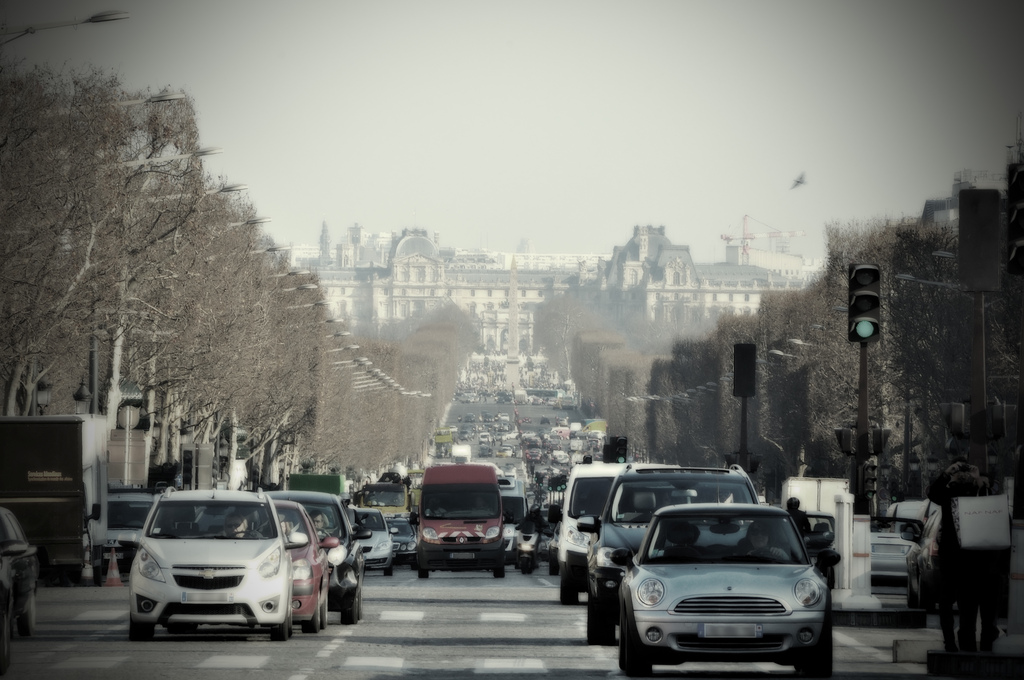
Avenue des Champs-Elysées, 8e Arrondissement
Like I said before, most restaurants here are overpriced tourist traps. However, I have one recommended restaurant:
- Hanawa: the best sushi in Paris, period. 26 Rue Bayard. M1, Franklin Roosevelt station.
Make sure to try parisian macaroons at Ladurée Champs-Elysées (75 Avenue des Champs Elysées, M1 George V station) as well.
Hotels in this area are very expensive. The best ones are:
- Four Seasons Hotel George V, M1, George V station.
- Hôtel de Crillon, M1, M8 or M12, Concorde station.
- Hyatt Paris Madeleine, M9, Saint Augustin station.
- Sofitel Paris Le Faubourg, M1, M8 or M12, Concorde station.
9e Arrondissement
A very mixed area, composed of the shopping Grand Boulevards area and the Opéra Garnier to the south, and the old, decaying district of Pigalle to the north. Visitors will probably hang out in the southern area (Opera district). The main landmarks are:
- Grands Boulevards: famous boulevards where many department stores are located. The most visited are Printemps and Galeries Lafayette at Boulevard Haussmann. The dome inside Galeries Lafayette is very beautiful and is worth a visit. M7 or M9, Chaussée d’Antin-Lafayette station, or M3 or M9, Havre-Caumartin station.
- Olympia Bruno Coquatrix: a famous concert hall where many music shows happen in the city. M8, M12 or M14, Madeleine station.
- Opéra Garnier: mostly known as the setting for The Phantom of the Opera. Although most opera performances in Paris now typically take place at Opéra Bastille, this continues to be a very important venue for classical music and ballet. The interior is phenomenal and is worth a visit. The restaurant has an interesting architecture by Odile Decq. M3, M7 or M8, Opéra station.
Recommended restaurants:
- Bouillon Chartier: good and cheap food, menus change daily. Arrive early, or face long lines for dinner. 7 Rue du Faubourg. M8 or M9, Grands Boulevards station.
- L’Opéra Restaurant: not very consistent, but if you are lucky and get a good day, it is fine. For lunch, it is a convenient option for a €36 menu if you are exploring the surroundings. Opéra Garnier. M3, M7 or M8, Opéra station.
Recommended hotel:
- Hôtel Scribe (Sofitel), M3, M7 or M8, Opéra station.
10e Arrondissement
The 10th is centered around Canal St. Martin. There isn’t much to do here for the typical tourist, apart getting in or out the city via the two major train stations in the area: Gare du Nord (where the Eurostar arrives/departs) and Gare de l’Est. If you want to try a different atmosphere, go for a walk along the canal, starting at the Place de la République (M3, M5, M8, M9 or M11, République station).
11e Arrondissement
Not very touristy, but there are a lot of bars and restaurants where locals hang out at night. The only thing to see here is the Cirque d’Hiver, which was a venue for circuses in the winter, as the name suggests (M8, Filles du Calvaire station).
12e Arrondissement
A giant district, thanks to the huge Bois de Vincennes, a 2460 acre park. There are some interesting things to see here:
- Bercy Village: a bit of countryside shopping inside Paris. M14, Cour Saint-Émillion station.
- Bois de Vincennes: a huge park that covers a 2460 acre area. Many paths, lakes, islands and a Buddhist temple can be found within. At the very northern end of it, in the town of Vincennes, you will find the Château de Vincennes, a 14th century castle. M8, Porte Dorée station (for the park), or M1, Château de Vincennes station (for the château).
- Palais de la Porte Dorée: a very beautiful building that houses an immigration museum and a tropical aquarium. M8, Porte Dorée station.
- Parc de Bercy: a nice park near the Gare de Lyon. In the middle of it, you will find the Jardin Yitzhak Rabin, which is a very beautiful garden full of waterworks and landscape art. Next to the park, there is the Palais Omnisports de Paris-Bercy, an indoor sports arena. M14, Cour Saint-Émillion station, or M6 or M14, Bercy station (closer to the Omnisports).
- Picpus Cemetery: for the people interested in the American Revolution, here lies the Tomb of Lafayette, George Washington’s friend and fellow soldier. M1, M2, M6, M9 or RER A, Nation station.
Recommended restaurant:
- Le Train Bleu: a good haute cuisine restaurant in the 1st floor of the Gare de Lyon. Quite pricey, and you are definitely paying for the glamorous interior rather than the food. Reservations are a must here. Gare de Lyon. M1, M14, RER A or RER D, Gare de Lyon station.
Recommended hotels:
- Mercure Paris Gare de Lyon, M1, M14, RER A or RER D, Gare de Lyon station.
- Novotel Paris Gare de Lyon, M1, M14, RER A or RER D, Gare de Lyon station.
13e Arrondissement
Mostly a residential and business area, known for the parisian Chinatown in the south of the district. For visitors, the interesting place to see here is the Bibliothèque Nationale de France, a huge library that holds 5000 Greek manuscripts, among other important historic documents. M14 or RER C, Bibliothèque François Mitterrand station.
Recommended hotel:
- Mercure Paris Place d’Italie, M5, M6 or M7, Place d’Italie station.
14e Arrondissement
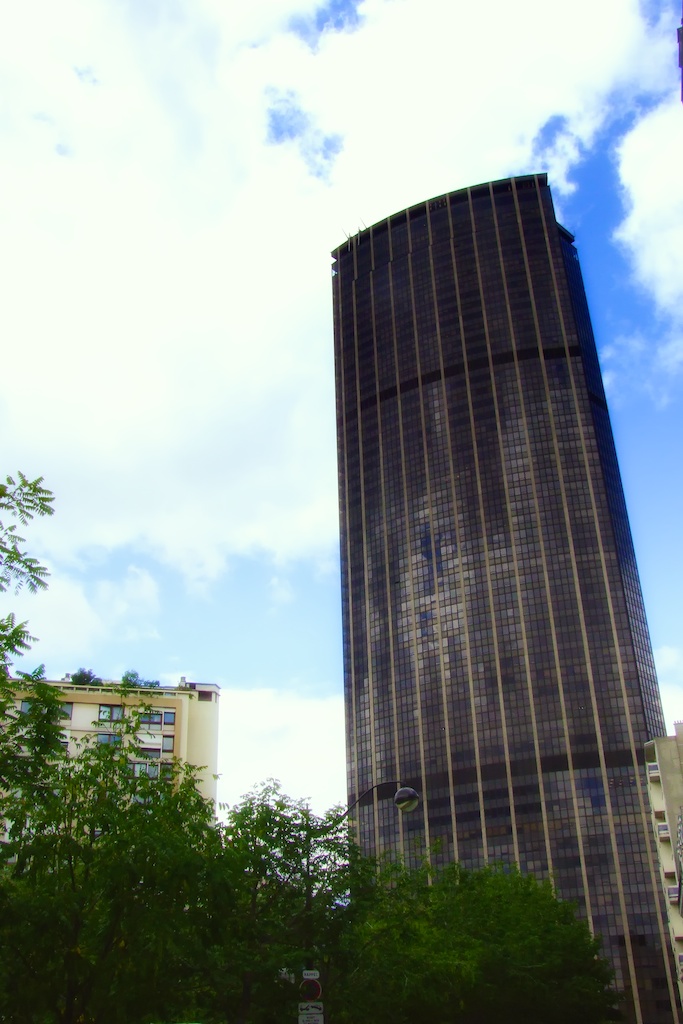
Tour Montparnasse, 14e Arrondissement
A residential area, famous for the Tour Montparnasse and Gare Montparnasse (train station). There are a bunch of things to see in this district:
- Cimetière de Montparnasse: some famous people are buried here, including: André Citröen, Camille de Saint-Saens and Pierre Larousse. M6, Edgar Quinet station.
- Les Catacombes de Paris: the catacombs are quite interesting. The maze of tunnels contains several piles of bones and skulls of about 6 million people. M4, M6 or RER B, Denfert-Rochereau station.
- Observatoire de Paris: although not currently open to public, it is an interesting building and another location that marks the old Meridian of Paris (the other is at Parc Montsouris). M4, M6 or RER B, Denfert-Rochereau station.
- Parc Montsouris: one of the most beautiful parks in Paris. Here you can see the remains of the old Petite Ceinture railway and a monument that marks the old Meridian of Paris. RER B, Cité Universitaire station.
- Tour Montparnasse: the second tallest skyscraper in France (210m / 689ft) offers the best aerial view of Paris — and the lines are much shorter than the Tour Eiffel’s. You can see the Eiffel Tower and you can’t see Tour Montparnasse’s ugliness, so it’s a win-win. The famous restaurant Le Ciel de Paris is located on the 56th floor. M4 or M12, Montparnasse-Bienvenue station. M6 or M13 also work, but the exit is at Gare Montparnasse, so you will need to walk a bit.
Recommended restaurants:
- Crêperie Josselin: my favorite crepe place in Paris — excellent crepes and cider. Beware of long waiting times. 67 Rue de Montparnasse. M6, Edgar Quinet station.
- Le Ciel de Paris: best view of any restaurant in Paris. The food is good, but is kind of hit-and-miss, so good luck. Like the Le Train Bleu, you are paying more for the location than the food. Tour Montparnasse, 56th floor. M4 or M12, Montparnasse-Bienvenue.
Recommended hotels:
- Hôtel Le M. M6, Edgar Quinet station, or M13, Gaité station.
- Pullman Paris Montparnasse. M6 or M13, Montparnasse-Bienvenue station.
15e Arrondissement
Not much to see here, as this area is largely residential. Business travelers may be here for the Parc des Expositions, one of the largest exhibition centers in Europe (M12, Porte de Versailles station).
16e Arrondissement
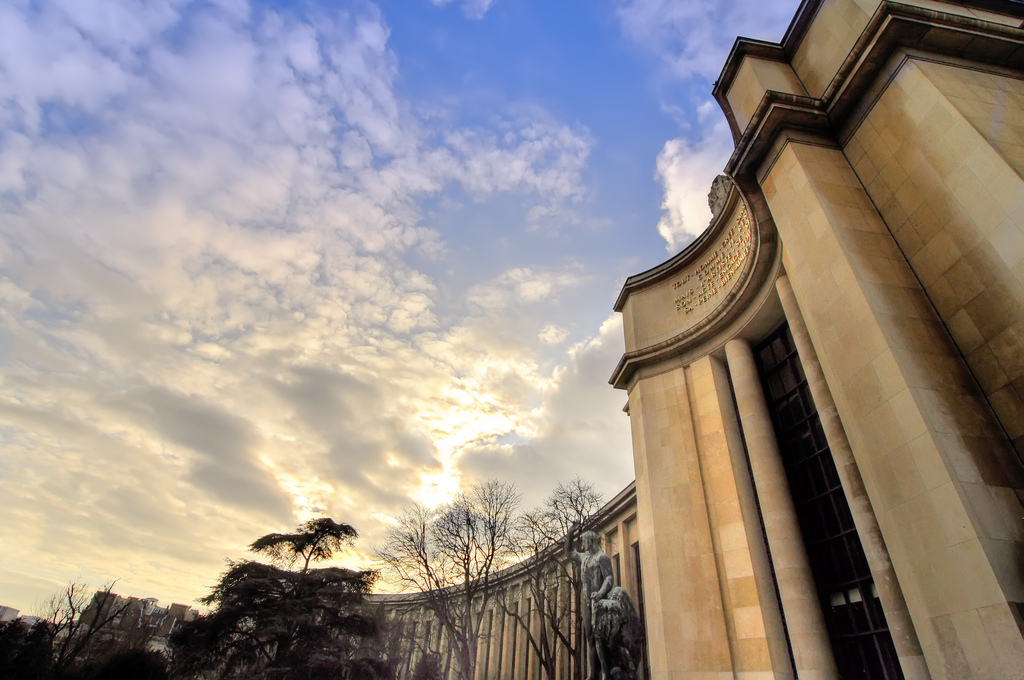
Palais de Chaillot, 16e Arrondissement
Most tourists will come here to see the Tour Eiffel from the Palais de Chaillot. A great area of the 16th is covered by the Bois de Boulogne, a very large park (over 2000 acres). Just a few sights here:
- Bois de Boulogne: a very large park. The most interesting thing to see here is the Jardin de l’Acclimatation, an old amusement park in the northwest corner of the park. M1, Les Sablons station.
- Musée Marmottan: the best and largest Monet collection in the world. M9, La Muette station.
- Palais de Chaillot: a palace built to replace the old Palais du Trocadéro that houses 4 museums: Musée National de la Marine (Naval Museum), Musée de l’Homme (Ethnology Museum), Cité de l’Architecture et du Patrimoine (Architecture Museum) and the Musée Nationale des Monuments Français (French Monuments Museum). There is also a theater beneath the esplanade, the Théâtre Nationale de Chaillot. Also in the underground, lies the Paris Aquarium. M6 or M9, Trocadéro station.
Recommended restaurants:
- Astrance: very good modern haute cuisine by Pascal Barbot, very expensive. It doesn’t open on weekends. 4 Rue Beethoven. M6, Passy station.
- Les Tablettes de Jean-Louis Nomicos: cool interior, great modern French food, with a touch of Provence. Very expensive. 16 Avenue Bugeaud. M2, Victor Hugo station.
- Le Stella: the best brasserie in Paris, in my opinion. Try the onion soup, steak tartare and the roast lamb. 133 Avenue Victor Hugo. M2, Victor Hugo station.
17e Arrondissement
Very residential, nothing to see here.
18e Arrondissement
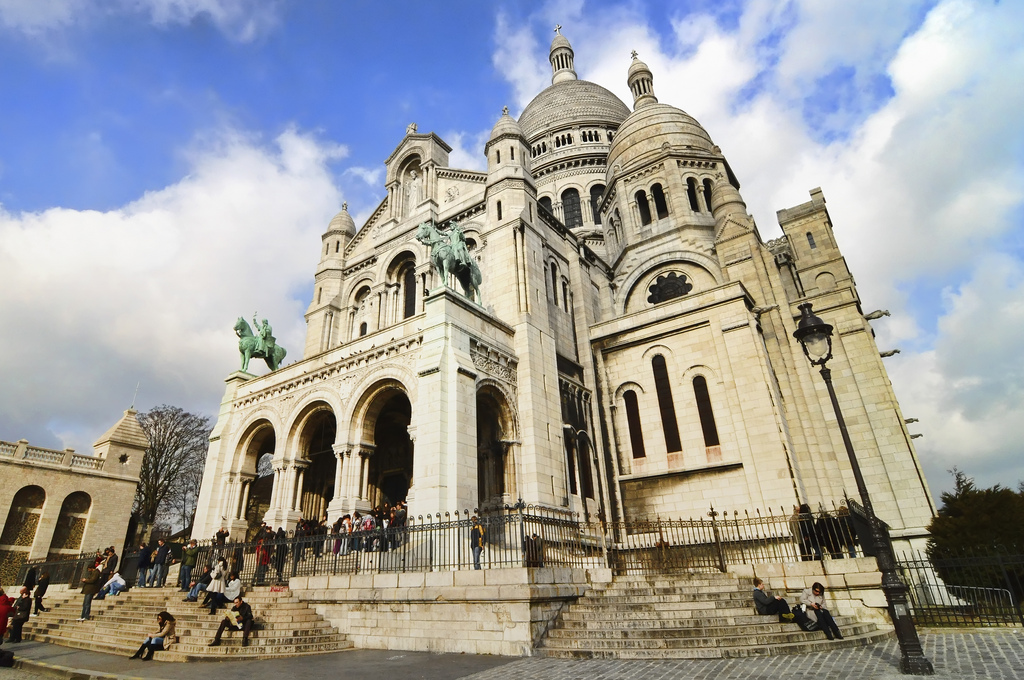
Basilique du Sacré-Coeur de Montmartre, 18e Arrondissement
Mostly known for Montmartre. Be careful here, as this is the roughest area in which you will probably wander as a tourist — lots of scammers and pickpockets. Avoid Pigalle at all costs. For the good things to see here, go to:
- Basilique du Sacré-Coeur de Montmartre: one of the most famous churches in Paris, standing at the top of the Montmartre Hill, the highest ground in Paris. Take the funicular on the left side of the stairs if you are not up for the climb on foot. M2, Anvers station.
- Marché aux Puces de St-Ouen: the largest flea market in Europe. M4, Porte de Clignancourt station.
- Moulin Rouge: the cabaret offers two shows every night at a very high price tag. The best seats are offered to those who buy tickets with drinks. M2, Blanche station.
19e Arrondissement
There is only one thing to see here: Parc de La Villette, a large cultural park with some attractions, like the Cité des Sciences et de l’Industrie (Sciences Museum) and the Philharmonie de Paris. M7, Porte de la Villette station (for the Science Museum), or M5, Porte de Pantin (for the Philharmonic).
20e Arrondissement
The only tourist attraction here is the Cimetière du Père Lachaise. It is probably the most interesting cemetery in the world. A lot of famous people are buried here: F. Chopin, Jim Morrison, Oscar Wilde, Delacroix, Bizet, and others. M2 or M3, Père Lachaise station.
This concludes the second part of this guide. In part 3, we will cover the outskirts of Paris, like Versailles and Puteaux (La Defénse).
* all photos were taken by myself and can be see in my Flickr gallery.
Pretty cool guide, congrats! You could add Cite Univerrsitaire in the 14eas well. Cheers.
Thanks! I’ll add it in the next update. Got a couple good tips I forgot in the original writing.